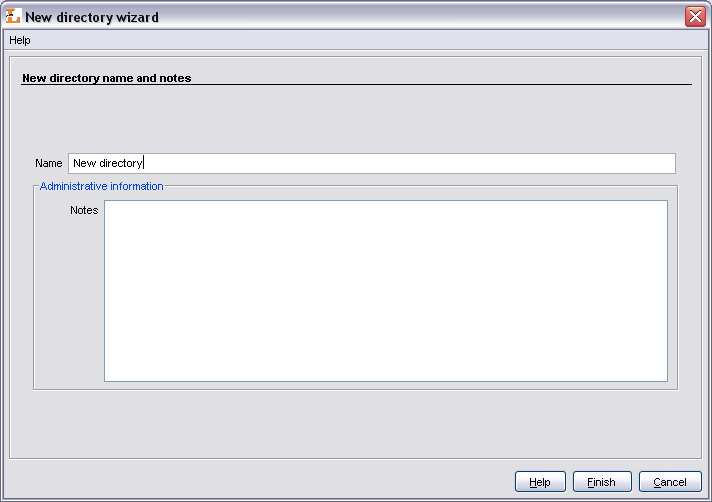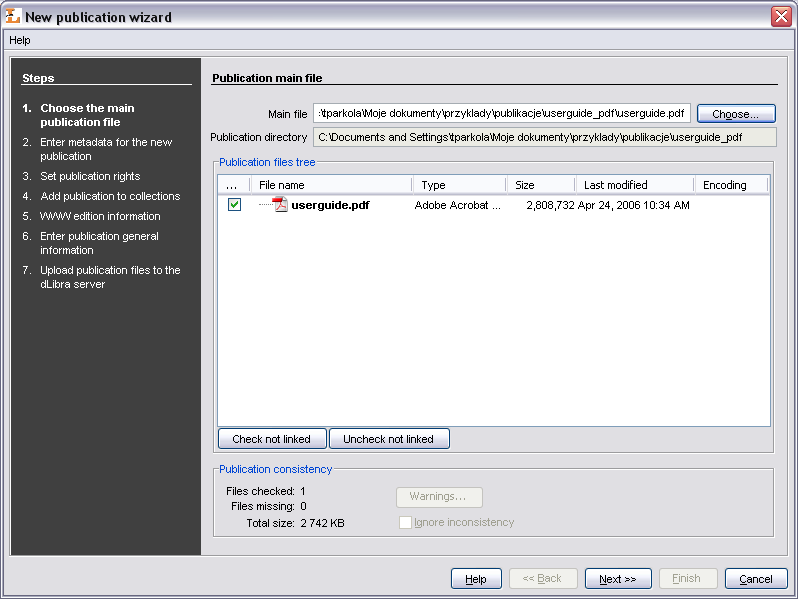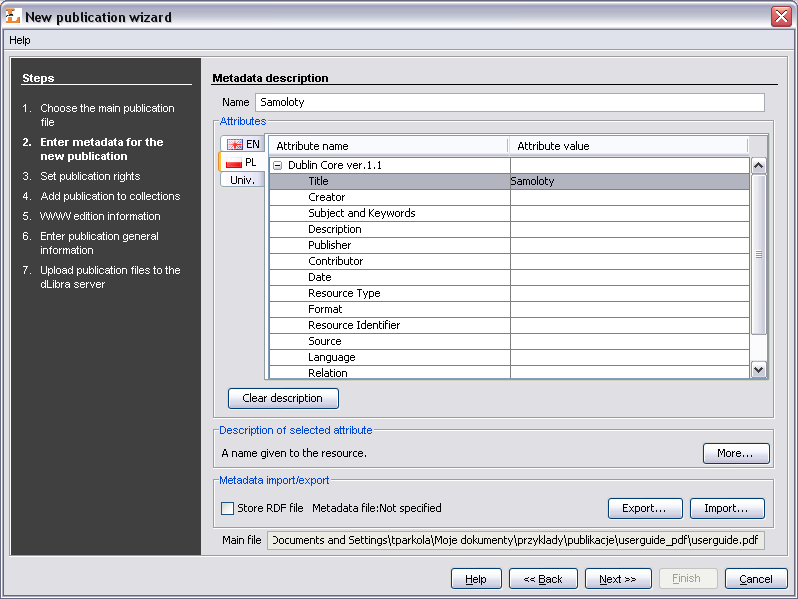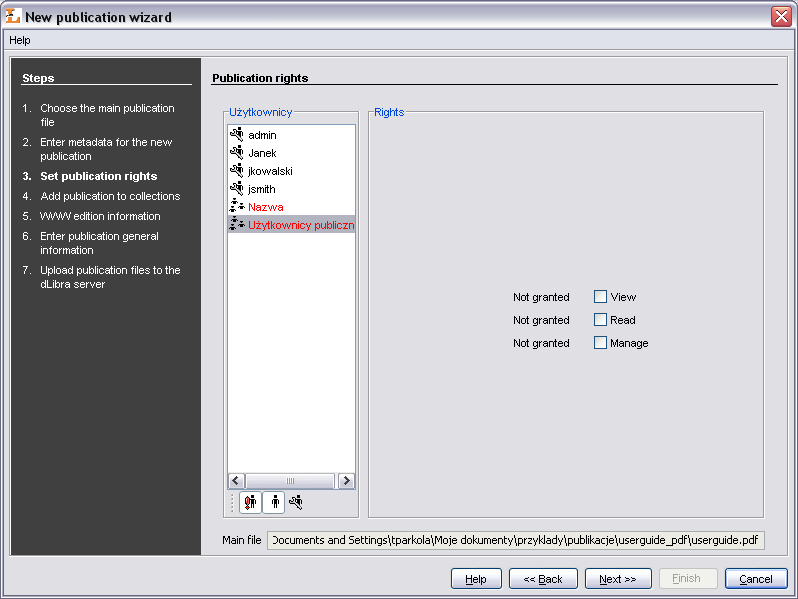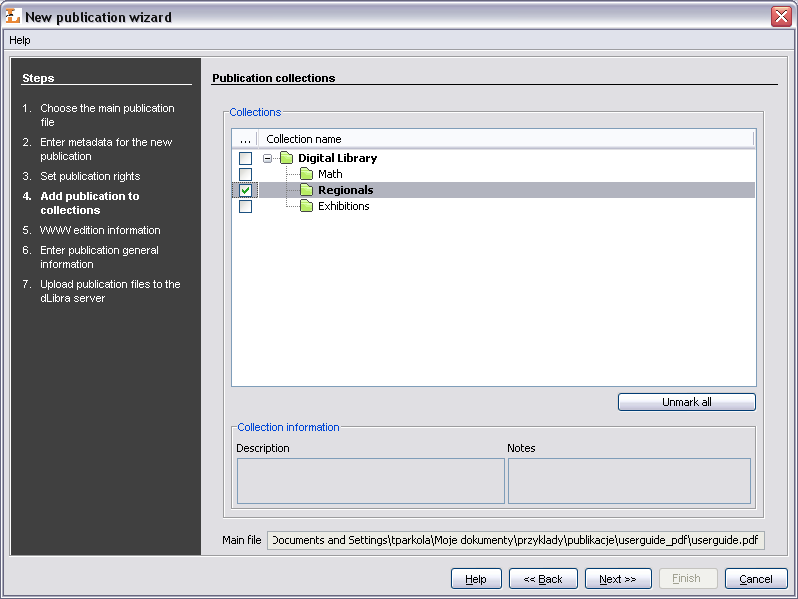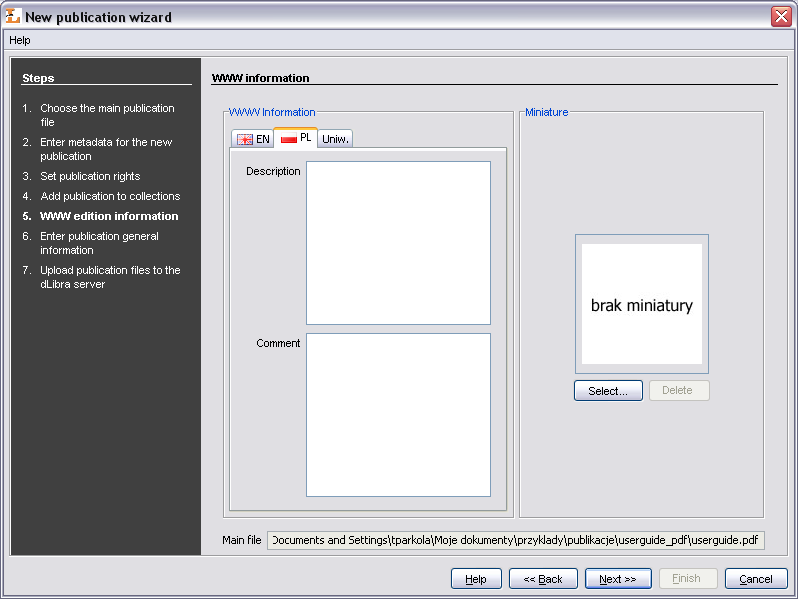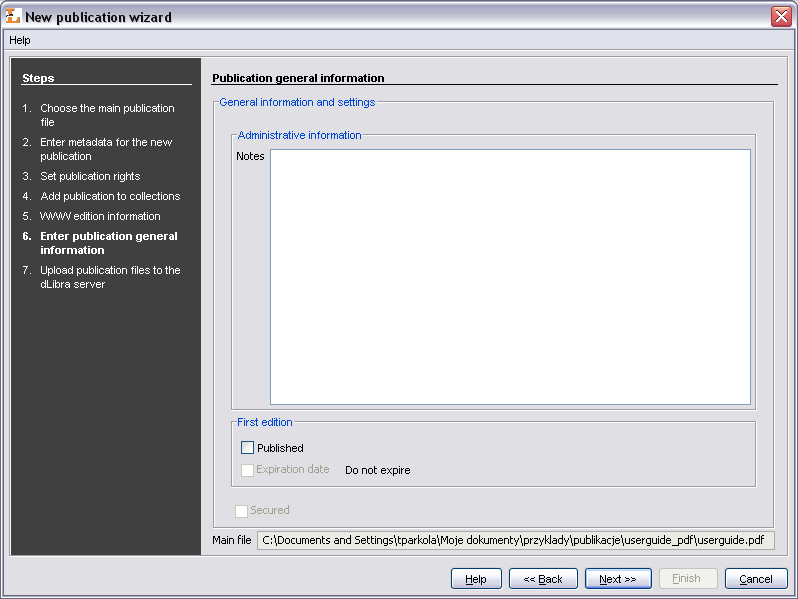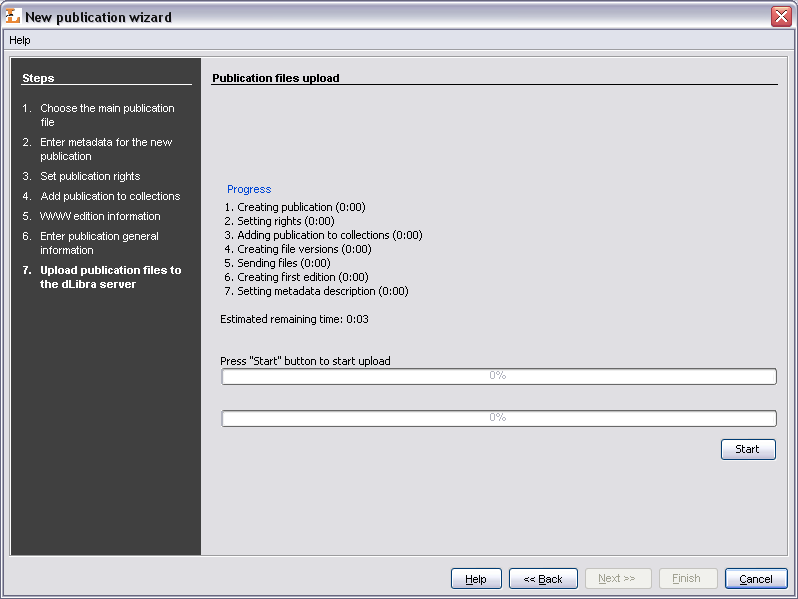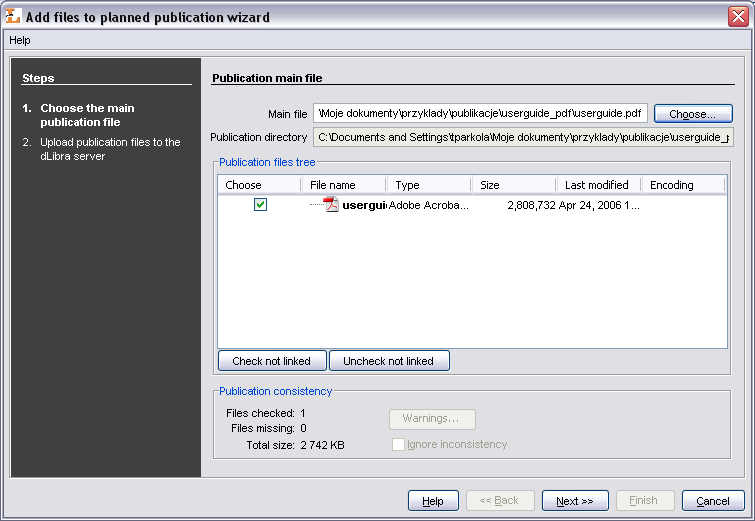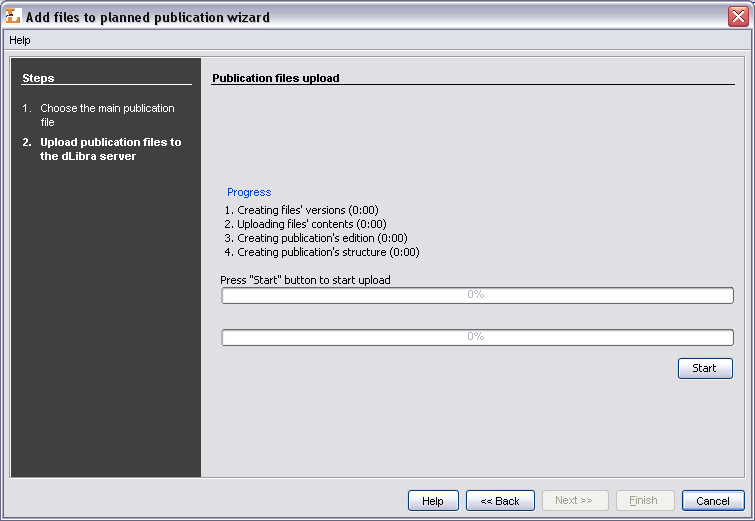This section describes typical editor's tasks. Full list of operations which may be performed on specific objects can be found in Appendix H, List of operations concerning objects of the dLibra system.
To remove an element:
In the directories tree or on the elements list select an element to remove.
From the popup menu select
 Delete option and
confirm operation. Alternatively, a main menu or toolbar (only in
case of an element selected on elements list) can be used.
Delete option and
confirm operation. Alternatively, a main menu or toolbar (only in
case of an element selected on elements list) can be used.In case of publication and directory which contains at least one publication it is possible to specify remove reason for publications. The remove reason is presented to the WWW if a user attempts to read publication.
There are two ways of moving an object. The first way is possible when editor application has two elements list visible (see???). In order to move selected element from one list to the open element of the second list press F6 key. Remember that moving huge amounts of object (eg. directory) may cause high server load caused by information actualization. The second way is to use “Drag and drop” (this way you can move element between elements list and directories tree).
To create a new directory:
On the elements list select destination directory (parent directory of new directory) .
From the popup menu select . Alternatively, the toolbar button
 or
main menu option can be used.
or
main menu option can be used.In the New Directory Wizard enter name and description for the new directory. Press Finish button to create the directory.
To create a new group publication:
On the elements list select the directory or group publication the new group publication should belong to.
From the popup menu select the New publication... function. Alternatively, the toolbar
 or
main menu option can be used.
or
main menu option can be used.Enter the name and notes for the new group publication and click button to finish.
![[Note]](gfx/admonitions/note.gif) | Note |
|---|---|
Before a new publication can be placed in the library all its files must be present in a directory on a local disk. | |
To create a new publication:
On the elements list select destination directory or destination group publication,
From the popup menu select the function. Alternatively, the toolbar
 button or
main menu option can be used,
button or
main menu option can be used,In the first step of the New Publication Wizard ( Figure 3.15, “New Publication Wizard - main publication file page” ) select the main publication file. If the publication content is in one file, for example PDF or MS Word document, choose this file. If the publication is composed of many files (e.g. HTML files) choose top level file (in case of HTML usually index.html).
If the main publication file is an HTML or DJVU file the wizard will try to find all publication files and verify consistency of the files. If there are any problems with files' consistency button will be activated so the user can press this button to see warnings. It is strongly recommended that only complete publications (without missing files) are put into the library. However, using the Ignore inconsistency option it is possible to proceed with an incomplete/inconsistent publication. All files that the publication consists of will be added to publication files table. There is no way to uncheck them, they all will be sent to the server.
Beside publication files, all the other files in main file's directory are listed on the files table. By default these files are not checked to send to the server. However it is possible to add additional files.
Notice that the main publication file and cannot be unchecked and it will always be sent to the server.
Press the button to move to the the page.
In the second step ( Figure 3.16, “New Publication Wizard - attribute values page”) publication may be described with a set of attributes. Bibliographic description may be imported from an external file (e.g. MARC, RDF, Master, Bibtex). Attributes values editor and import mechanism is described in the part concerning Bibliographic description editor. In order to proceed to the next step a publication name has to be given (field with Name label). By default the name is created basis on bibliographic description throught combining the title, author and publishing date. For example, if the title is “Stories”, author is “John Smith” and the publishing date is “2004” then the name will be “John Smith, 2004, Stories” --- first author, then publishing date and title. Whenever a user changes the attributes' values the name is updated. Press the button to move to the next steps.
In the third step ( Figure 3.17, “New Publication Wizard - publication rights page” ) user may grant appropriate rights for other users to publication. For more details about rights management for publication see section Rights editor. Press the button to move to the next steps.
In the fourth step ( Figure 3.18, “New Publication Wizard - publication's collections page”) user may assign publication to collections. See Publication's collections editor for details. Press the button to move to the next step.
In the fifth step ( Figure 3.19, “New publication wizard - WWW information”) it is possible to specify WWW information concerning the first edition of the new publication. WWW information consists of:
Description - short edition description, e.g. what does it concern, visible on WWW search results page (it is recommended to provide the description possibly short --- one or two sentences),
Comment - characteristic information concerning the edition, e.g. specific marks (for example the lack of one page),
Miniature - graphic edition representation visible on the WWW edition information page.
Press the button to move to the next step.
Step sixth ( Figure 3.20, “New publication wizard - general information”) allows user to provide general information:
Notes - administrative notes concerning publication
First edition - panel which allows for publishing the first edition (uncertain or time publishing)
Secured - if checked, publication will be secured - copying, printing will not be possible (applies only to HTML publications)
Uploading files on the server is the last step ( Figure 3.21, “New publication wizard - creating publication on the server”). Press the button to create publication on the server. The process can be paused and resumed by pressing the button again. During the creation process on the Progress panel all operation which have to be performed are presented. Operation which is being performed is marked with bold font. For every operation elapse time is measured and presented (in seconds) in the brackets after the operation name. Progress bars inform about progress the operation. When all operations are finished short summary is presented. During the creation process it is possible to cancel it (e.g. press the button).
To create a new planned publication
On the elements list select destination directory or group publication
From the popup menu select New planned publication.... It is also possible to select this option from toolbar or main menu.
Planned publication wizard consist of four steps. The first step is the same as the second step of new publication wizard. The second step is the same as the third step of new publication wizard. The third step is the same as the fourth step of new publication wizard. In the last, fourth step of new planned publication wizard ( Figure 3.22, “New planned publication wizard - general information” ) specify the administrative notes and information whether the publication should be secured or not (Secured check box).
To add files to planned publication:
On the elements list select a planned publication which you want to add files to.
From the popup menu select Add files....
Add content wizard consists of two stepts. The first step is the same as the firts step of new publication wizard. The second step ( Figure 3.23, “Add content wizard - sending content (files) on the server”) allows sending publication content on the server. In order to send selected files in the first step press button.
In order that reader could read publication's edition, it is required to assign to publication a “read” right for him and publish the edition. In order to publish the edition and assign a “read” right to the reader:
On the elements list select a publication which edition is to be visible for the reader.
On the edition's general information tab (Edition) select Published option.
On the rights assignment tab (Rights) select the user name (or group name - if we want to assign right to the group of users) which you want to grant the “read” right and then select the View check box.
In order to approve the changes press the button. The publication is now visible for users which have “read” right assigned.
Content deleting is useful when we want to remove publication content (files), but leave editions' bibliographic description and delete reason.
To delete publication's content:
On the elements list select a publication which content is to be deleted,
From the popup menu select Delete content... option.
Enter delete reason. Attention! The reason is required because it is presented when WWW reader visits publication page.
Every user of the editor and administrator program may change his/her password. In order to change password press option from menu. Change password window will appear. To change password provide current password, new password and confirm new password.
User may find an element in two different ways.
Searching for an element basis on bibliographic description,
searching for an element basis on its identifier.
Searching basis on bibliographic description gives the same results as searching on WWW page. In order to run this perform searching select option from menu.
To run searching basis on identifier select option from menu. Then select type of an element to find (e.g. directory) and type identifier of the element to find. If such an element exists it will be displayed and selected on elements list.
